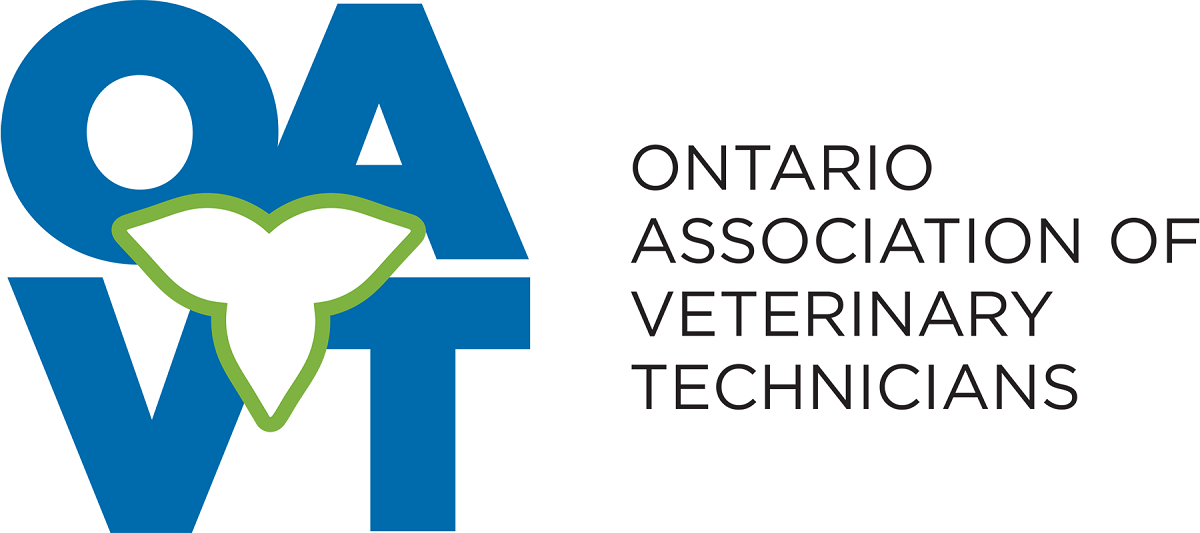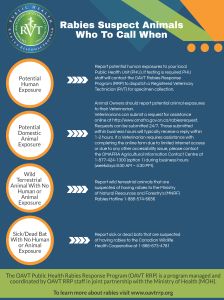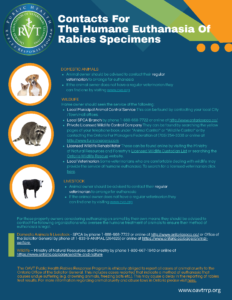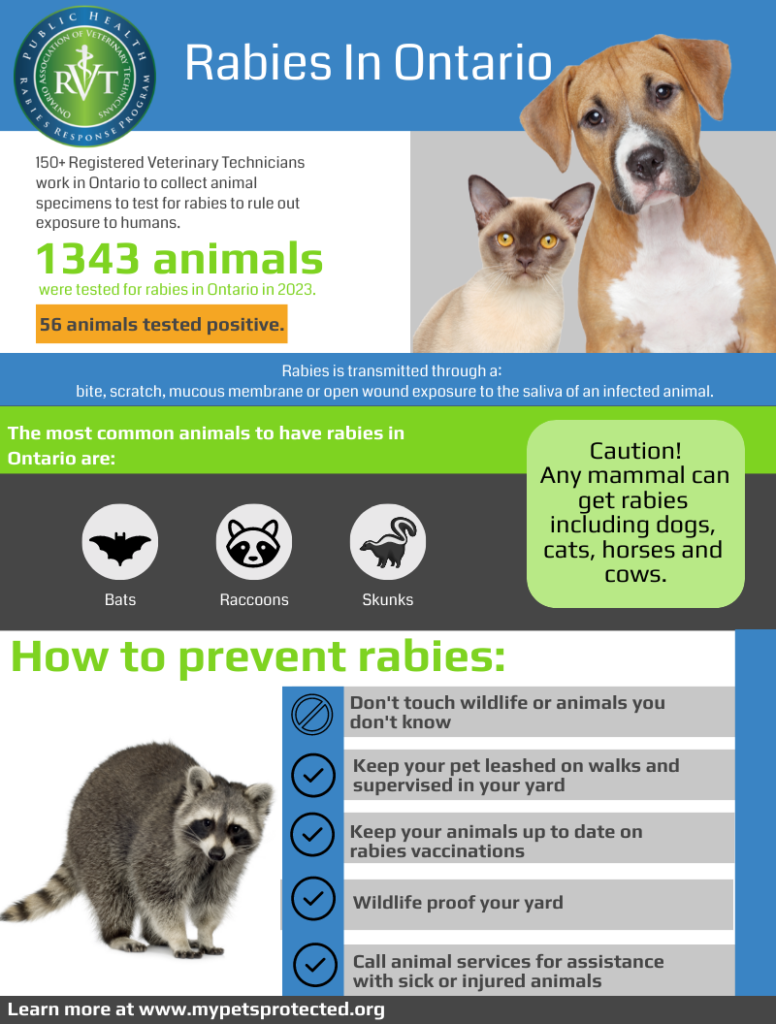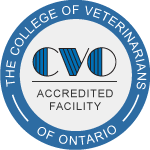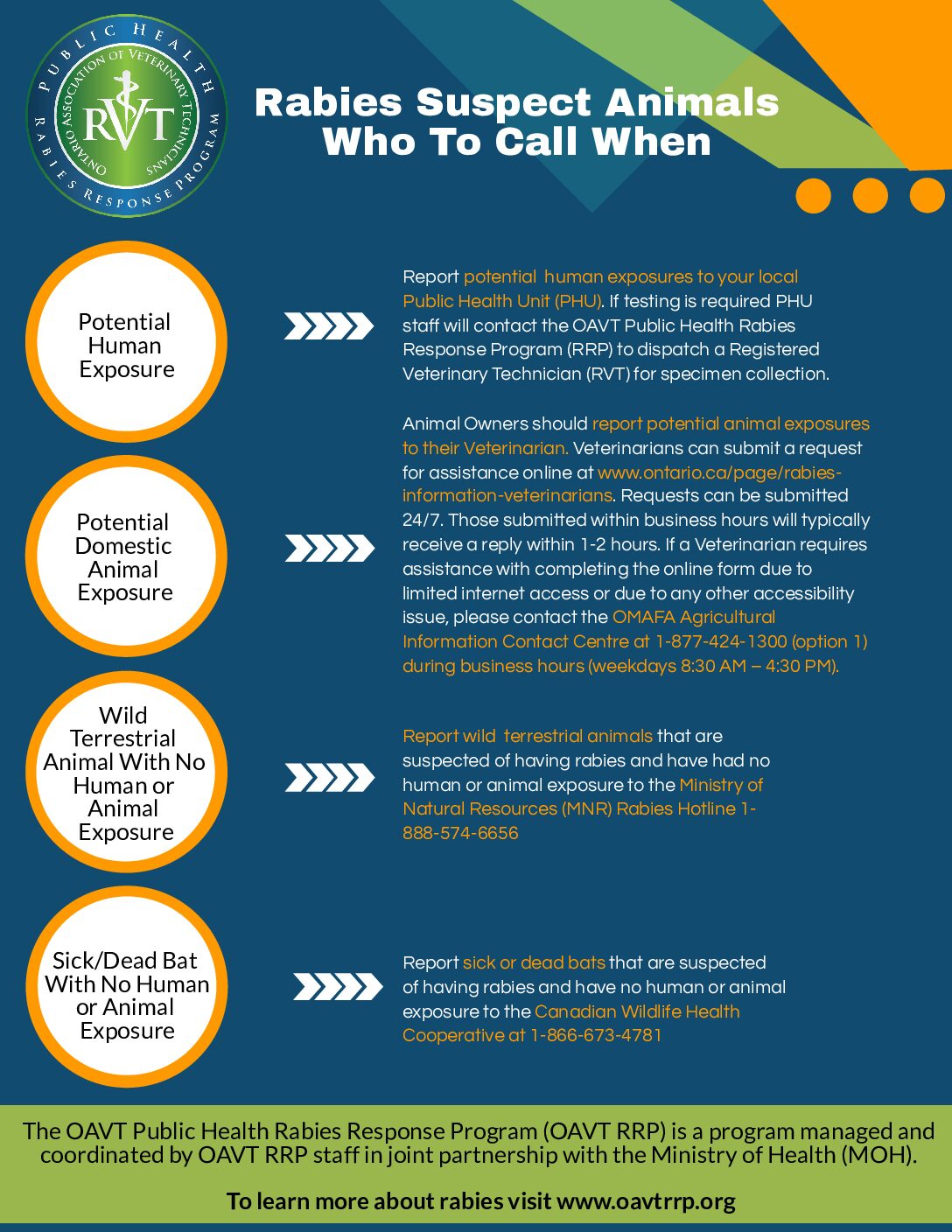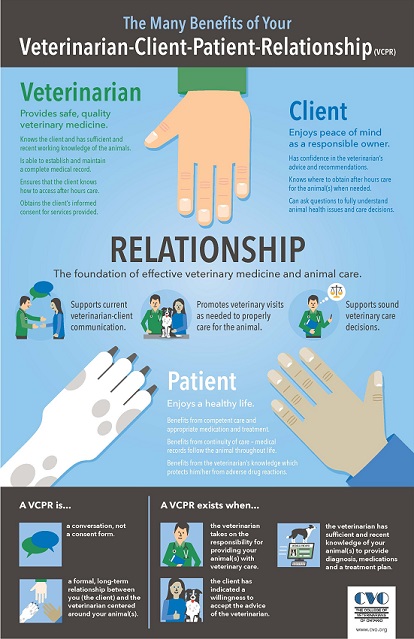Rabies Public Portal
Welcome to the OAVT Public Health Rabies Response Program (RRP) Public Portal!
What is Rabies?
Rabies is a viral disease, that affects the brain and central nervous system, and can be spread to mammals (including people and animals- both wild and domestic) through contact with saliva or nervous tissues from an infected animal.
The most common way rabies virus is transmitted is through a bite or scratch from a rabid animal. Rabies can also be spread when infected saliva or nervous tissue comes in contact with an open wound or is introduced into a mucous membrane like the eyes, nose or mouth.
In most cases, once symptoms appear, rabies virus is almost always fatal. Symptoms of a rabid animal may include:
- trouble walking or standing
- weakness
- paralysis
- seizures
- difficulty breathing
- difficulty eating/drinking/swallowing
- excessive salivation
- change in vocalizations
- behavioral changes (aggressive, quiet/depressed, unusually friendly)
- self mutilation
The main animals that transmit rabies in Ontario include: bats, skunks, raccoons and foxes.
For more information about rabies in Ontario please visit our Rabies Resources webpage.
Rabies In Ontario
Although rabies was occasionally detected in bats in recent years in Ontario, Canada everything changed in December 2015 when raccoon strain rabies was detected in the Hamilton ON area. This was the first time raccoon strain rabies was detected in Ontario in 10 years and the first time ever to be seen in the Hamilton area.
Since then an outbreak of the disease has occurred affecting mostly raccoons and skunks but has also involved other species including fox, dog, cat and llama. The raccoon strain outbreak also spread to other areas in Ontario including Brantford, Halton, Haldimand-Norfolk, Niagara and Waterloo. Currently over 523 positive cases have been seen in Ontario since the outbreak began with the most recent cases being found in skunks in St. Catharines, Ontario in 2023. There were no raccoon strain rabies cases found in Ontario in 2024. For more information on the developing rabies outbreak in Ontario click here.
Around the same time in December 2015 arctic fox strain rabies was also detected in a cow in the Perth ON area. A small pocket then developed in Ontario in the Perth, Huron and Waterloo and Wellington- Dufferin Guelph areas with 21 positive cases detected which have involved other species including skunk and fox. No cases of fox strain rabies were detected from 2019 to 2024 in Southern Ontario. However, two arctic fox strain rabies cases was found in far Northern Ontario in early 2025.
For more information about rabies statistics in Ontario, Canada click here.
What is being done in Ontario to Control Rabies?
Ontario is well complimented by three government Ministries that work together in the fight against rabies including the Ontario Ministry of Health (MOH), Ontario Ministry of Food and Agriculture (OMAFA) and the Ontario Ministry of Natural Resources (MNR).
The MOH works with public health when a person has potentially been exposed to a rabid animal. Cases of potential exposure are investigated by local public health staff who determine the requirements for animal rabies testing and quarantine as well as post exposure vaccinations for people. Need to find the phone number for your local Public Health Unit? Click here for a listing of Public Health Unit contacts.
The OMAFA works with cases where animals have been potentially exposed to rabid animals. Working with veterinarians, cases of potential exposure are investigated and a determination is made regarding the requirements for rabies testing, precautionary confinement and post exposure vaccinations for animals.
The MNR works with Ontario’s wildlife population providing rabies surveillance testing and wildlife rabies vaccine bait distribution in areas where rabies has been known to occur.
What should you do if you or your animal has potentially been exposed to Rabies?
If you or your animal may have been exposed to rabies through a bite, scratch or saliva exposure to a open wound or mucous membranes you should reach out to the proper Ontario Ministry or your Veterinarian. A risk assessment can be completed to determine the required actions (e.g. quarantine or confinement period, testing, post exposure vaccine for you or your animal).
How should an animal be euthanized that requires rabies testing?
Not all animals require rabies testing. Those that can’t undergo a confinement or quarantine period, due to it being inhumane to do so, may require humane euthanasia. This should only be conducted by a licensed professional. Drowning animals, freezing bats etc. are not humane methods of euthanasia and can be subject to legal penalties. To access humane euthanasia in your area please see our humane euthanasia contacts infographic below.
Rabies can be prevented with vaccination
In cases of human exposure, if a vaccine is given before symptoms appear, the disease can be prevented from progressing.
In animals, routine preventative vaccinations for rabies can keep both your pet, family and community safe from rabies by providing immunity to the disease.
In Ontario, under the Health Protection and Promotion Act, Regulation 567, animal owners have a legal obligation to maintain rabies vaccinations for their animals. Dogs, cats and ferrets that are 12 weeks of age or older must be vaccinated. Livestock such as horse, cow, bull, steer, calf, sheep or other livestock are required to be vaccinated unless they only have contact with the people who have care and control of them. Vaccine boosters every one or three years (depending on manufacturers guidelines) are required to maintain immunity levels.
What is World Rabies Day?

World Rabies Day is recognized every year on September 28th as a global day of action for rabies awareness and prevention and was created by the Global Alliance for Rabies Control (GARC). It is the anniversary of the death of Louis Pasteur, who developed the first rabies vaccine and laid the foundations of rabies prevention.
Each year hundreds of thousands of people organize or participate in events to celebrate rabies prevention efforts and unite against rabies. Whether you’re a veterinarian, a medical professional, a teacher, or even someone who just cares about your community, it is a chance to organize or take part in an event that raises awareness about rabies and its prevention. It is the first and only global advocacy, education, and awareness campaign for rabies. It has the support of all international health organizations and major stakeholders including the WHO, OIE, FAO and CDC.
In this section
Rabies Vaccine Clinics- Ontario, Canada
To find a listing of rabies vaccine clinics in Ontario please click here.
Rabies vaccinations help to keep both animals and people safe from rabies. In Ontario, rabies vaccination clinics are accredited by the College of Veterinarians of Ontario and supervised by licensed veterinarians. To find a veterinarian in your area click here.
Rabies isn’t the only thing to worry about!
Although rabies vaccination is an important part of your animal’s health care, disease prevention and treatment does not stop at rabies. It is important to build a relationship with a Veterinarian and their veterinary healthcare team to ensure all of your pets medical needs are taken care of. This may include: health examinations, preventive vaccinations and treatments against other diseases that are integral to the well being of your pet. Building this relationship will enhance the quality of life your pet receives. For more information on how to keep your pet healthy click here.
What is the OAVT RRP?
The Ontario Association of Veterinary Technicians Public Health Rabies Response Program (OAVT RRP) is a program managed and coordinated by OAVT RRP staff in joint partnership with the Ministry of Health (MOH). The OAVT RRP provides the service of animal rabies specimen collection and shipping to laboratories for rabies testing. This much-needed rabies surveillance program utilizes the skills of Registered Veterinary Technicians (RVTs) in the process of specimen collection and shipping throughout the Public Health Unit (PHU) regions across the Province of Ontario. Animal specimens tested include wildlife, livestock, companion animals and zoo animals.
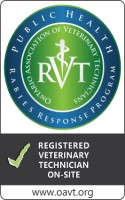
How do I become an RVT
Whether you are an Ontario student or internationally trained graduate, learn about the five steps it takes to become a Registered Veterinary Technician.
Job Board
Search through Ontario’s #1 source for animal healthcare jobs. New jobs are posted daily.
RVT Registry
The official Registry of Ontario’s Registered Veterinary Technicians. All RVTs in good standing can be found in this searchable Registry.
